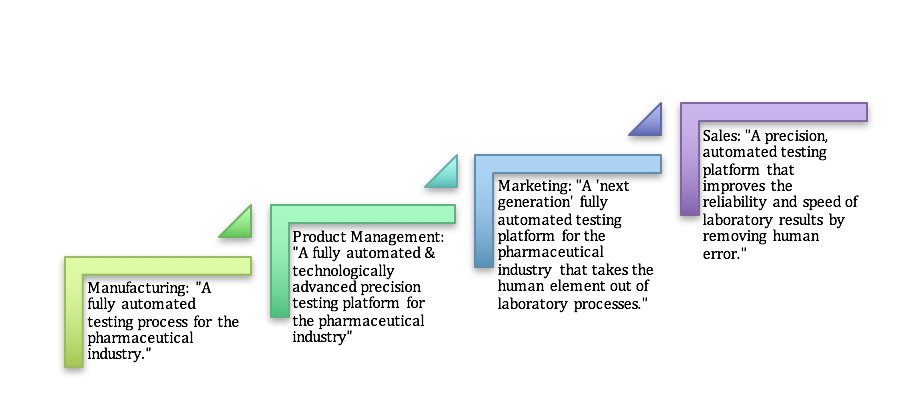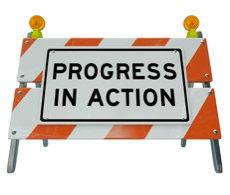Consider for a moment the “life cycle” of a value proposition for a testing product in the pharmaceutical science area.
It began (see the image below) with a very brief technical description. Then the product development group took a stab at writing a description. At the third stage, marketing got involved and the lipstick and eyeliner got applied. But it still didn’t connect with buyers.
Then we had the opportunity to work with several members of the sales team. It took about thirty minutes, some well placed questions and the sales team’s insight into their customers’ needs. We weren’t looking for “sexy” or “wow factor.” We were looking for “unique,” “compelling,” “urgent” and “can’t do without.”

In the life cycle of this value statement the sales team is striving to connect the product—a new testing device (actually several interconnected devices)—with the needs of scientists who are challenged with publishing the results of their research in journals and other documents. “Automated” and “precision” are two important qualities but the first three value statements don’t clearly articulate the benefits the researchers (and their organization) will glean from the product.
Marketing’s contribution lies in the introduction of “human element” but doesn’t clarify how that improves research or laboratory processes in some measureable way. So sales brought the package home by adding “improves reliability and speed of laboratory results.” Further, sales changed “human element” to “human error.” Now we can apply measures and track progress.
Also, our sales team can hammer on their marketing colleagues to come up with evidence of speed and reliability to answer questions about quantification and documentation. Everyone did their job and contributed to a successful outcome.
Find a Model that Works
 It seems that every blog, article or chapter in a book that mentions value propositions also includes a template for crafting a value statement. That’s helpful until the seller begins to apply various formats only to discover that they don’t fit, explain or clarify the value of his/her product, service or solution. Our recommendation is to stay away from the “fill in the blanks” templates and look more closely at formats that raise questions (for the seller to answer) or identify characteristics that the author should strive to achieve in the value statement. In this regard, there are many templates that may suite a seller’s needs. Three provided below may be helpful.
It seems that every blog, article or chapter in a book that mentions value propositions also includes a template for crafting a value statement. That’s helpful until the seller begins to apply various formats only to discover that they don’t fit, explain or clarify the value of his/her product, service or solution. Our recommendation is to stay away from the “fill in the blanks” templates and look more closely at formats that raise questions (for the seller to answer) or identify characteristics that the author should strive to achieve in the value statement. In this regard, there are many templates that may suite a seller’s needs. Three provided below may be helpful.
- “Who? What? Why? How? How Much?” In one form or another many experts cite this simple approach. Every good value statement should answer these questions. Rather than writing a value statement at the onset, the seller might list multiple responses to each question. For example, “who” asks the seller to identify a characteristic that defines the target of the value proposition. “Who” may refer to an industry, market, geographic grouping, level in an organization or executive who is faced with a particular challenge or opportunity. “What” describes the product/service/solution. “Why” should convey the benefit the product provides to the buying organization. “How” describes how the seller’s solution differs from the competition. “How much” challenges the seller to quantify the change likely to result from the buyer’s purchase. It’s a simple template but it moves the seller in the right direction.
- “The Combo.” The combo is a value statement that connects several benefits into a single sentence or two. For example, “Never has our industry seen a mobile device with this speed and range at this low a price.” Or “If you are interested in a mobile solution that your customers can use with speed, convenience and reliability, this is your best choice.” Unfortunately, the temptation is to use “buzz” words that fail to convey the nature, impact and scope of the benefit to the buying organization. The combo is often an attempt to flash several benefits in the hopes that one will connect with the buyer.
- Rackham’s Model. In their 1999 book Rethinking the Salesforce, Neil Rackham and John De Vincentis argue that effective value propositions should include four elements: capability, impact, proof and cost. Sellers would do well to make a master list of product capabilities, their impact on the buying organization, documentation of proof and consider how best to position cost.
Five Temptations to Avoid
- One size fits all customer value needs. No matter how powerful the message may seem, different customers at different levels of the buyer organization have different needs and priorities.
- Values that don’t differentiate or resonate. Strike benefits that can be easily claimed by the competition.
- Mistaking a product feature as a value. Focus on what the product does for the customer. The old adage fits: “They are buying holes, not drills.”
- Mistaking buyer curiosity for urgency. Urgency has its own language. Use it to create a more compelling statement.
- Overlooking hidden sources of risk. All purchases represent a risk. Minimize or control risk for buyers who are risk-averse.
Parting Thoughts
In the progression from good to better and best, customize the value statement to fit the buyer’s interests, desired benefits and language. Test value statements with coaches and other sellers who have experience with similar buyers. Listen to how customers describe their ideal solution and use that profile as a model for crafting your value message.


